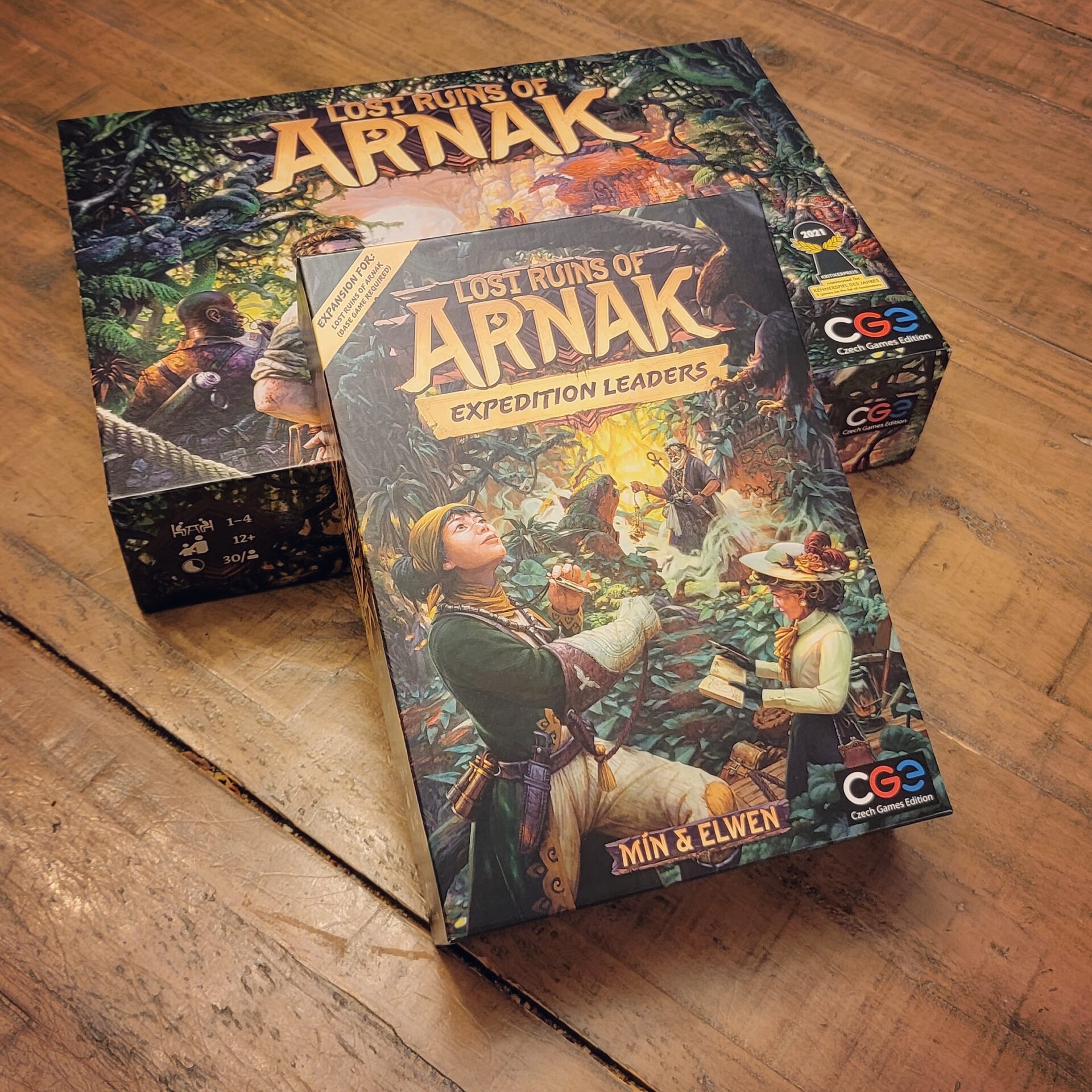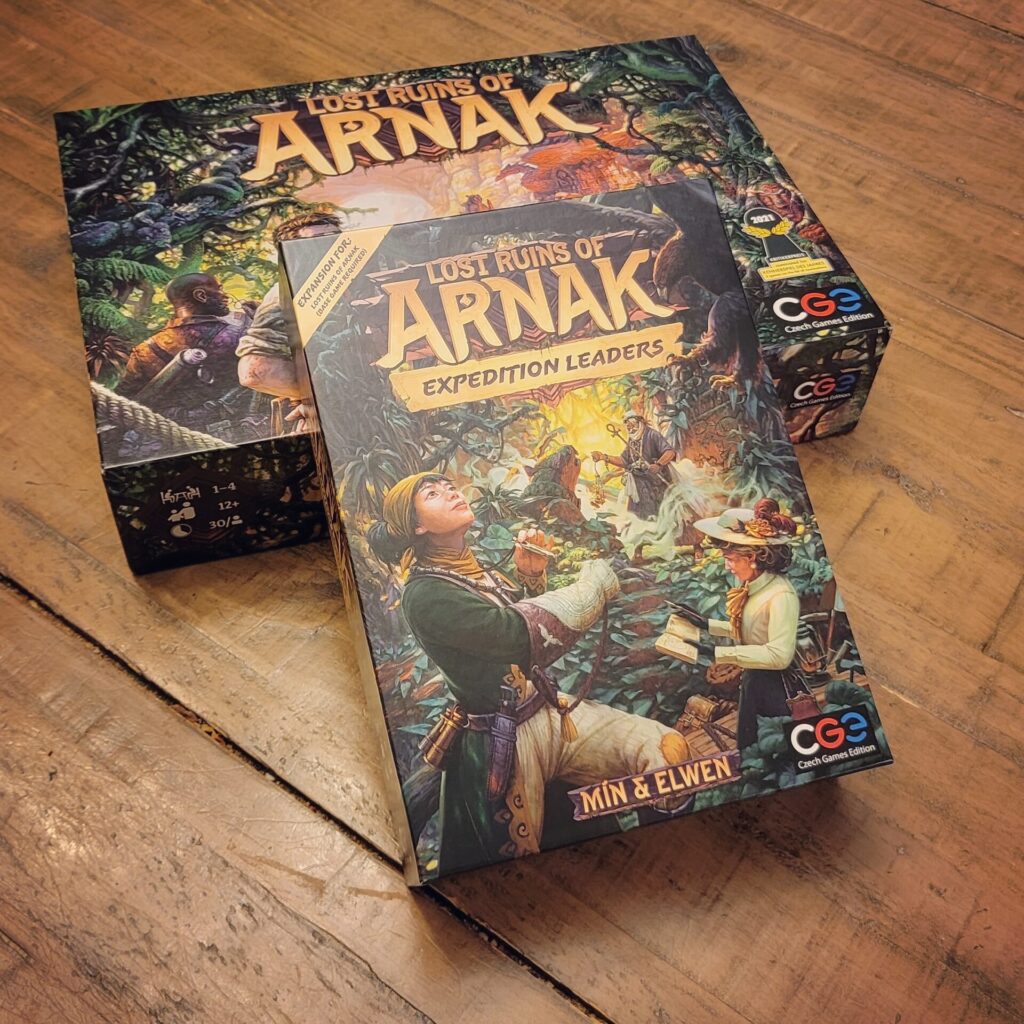
Name: Lost Ruins of Arnak – Expedition Leaders
Year of Release: 2021
Player Count: 1 – 4 Players
Playing Time: 30 – 120 minutes
Designer: Min & Elwen
Publisher: Czech Games Edition
Primary Mechanisms: Worker Placement, Hand Management, Variable Player Powers
Weight (According to boardgamegeek.com): 3.05
Overview
Now the secrets will be revealed. Now the doors will be unlocked. For we have brought ourselves to Arnak, and our techniques are unlike those of any expedition that has come before.
This is the text printed on the front of the Lost Ruins of Arnak: Expedition Leaders instructions and hints at the main changes between the base Lost Ruins of Arnak and the expansion. Truth be told, I only played the base game once with a physical copy (and a few times virtually on Board Game Arena) before I tossed in Expedition Leaders and there is no going back. I even taught this to my wife with the expansion implemented and afterwards, she was shocked to realize that she learned it with the expansion tossed in. Since I would highly recommend getting both the base and the expansion and playing with both from the get-go, I will be writing this review of both of these products packaged together as just Lost Ruins of Arnak. I don’t think it’s important to harp on what is different between the base and expansion but plenty of other reviews do that so I will leave that up to them. Suffice it to say, I can’t see playing without the Expedition Leaders expansion and if you’re even a little bit interested in this game, do yourself a favor and grab both of them immediately.
Now that we’ve found a good place to pitch our tents, with fresh water nearby, let us move on with the business at hand… discovering Arnak!
Rulebook and Setup
It is a long-standing joke with my wife and children, and even some of our friends, that I love reading rules. It doesn’t even have to be rules having to do with board games. If we go to a national park to hike, I like to scan the board where the maps are posted and take a quick look at the rules, even though they hardly change from park to park. At a neighborhood pool? Well, let’s take a few minutes to take in the posted rules just to make sure.
I’ve read about a lot of people really enjoying the act of punching out all the little pieces and organizing a new game, and while I enjoy that feeling, nothing beats the rush of sitting down with the rulebook and ingesting every detail and picture. Most of the time, it’s the first real instant that I’m coming in contact with the ins-and-outs of the game. While I do read reviews here or there before purchase, I typically don’t take in too many “how to play videos” because I don’t want to spoil the surprise of thumbing through the manual and getting in touch with the game.
The rulebooks for Arnak are top-notch. Between the base game and the expansion, you get a whopping 48 pages comprised of detailed pictures, thorough breakdowns of setup and actions, and even some flavor text to make you feel that you’re truly part of the expedition. I truly can’t say enough about the rulebooks as I never experienced a “head-scratching” moment while reading and if I ever forgot anything during my first few plays, I was able to find the answer quickly and get back to playing.
Setup is the standard fare when compared to similar games. My last two player game took me about 15 minutes to set out, which I don’t think is bad considering there are quite a lot of components here. The other nice thing about set up is there are variables from game to game. The main board is two sided, and there are two main differences between the sides. The first comes in the form of the temple printed on the right side of the board. This is where your research tokens (magnifying glass and notebook) will ascend, opening up new bonuses and most importantly, allowing you to get assistants. The other difference is that the location sites you explore cost different combinations of travel resources (boots, jeeps, boats, and planes) when compared to the opposite side.
Time for my first gripe and that has to do with the temple board that came with Expedition Leaders. Yes, it’s awesome that they gave the player a brand-new two-sided temple board to ensure that play was balanced with the new leaders being used but I really hate how it just sits on top of the board. I find that it slides around too much while playing because players are going to be touching and moving their research tokens a lot in this game. No, it’s not a deal breaker by any means but I wish there had been a way on the original board to secure any additional temples so that they stayed stationary.
My second gripe has to do with the word fiddly. Fiddly is one of those words that I frequently associate with board games. The problem is that I don’t really know what makes me describe a game in this way, it’s just a certain feeling. In the context of Lost Ruins of Arnak, I find the setup fiddly but not the actual gameplay. I say this because many of the components are tiny stacks of tiles or runes that must be shuffled and turned over and then placed in their specific little boxes on the board. There are decks of cards that have to be separated and shuffled, large tiles that need to be shuffled and stacked, and a multitude of resources to be placed in their individually marked areas near the beach. None of this is hard or too time consuming, but I just don’t love doing it. It does give me a great excuse after we’ve played it to say “hey, let’s just play again so I don’t have to set up next time.”
Components
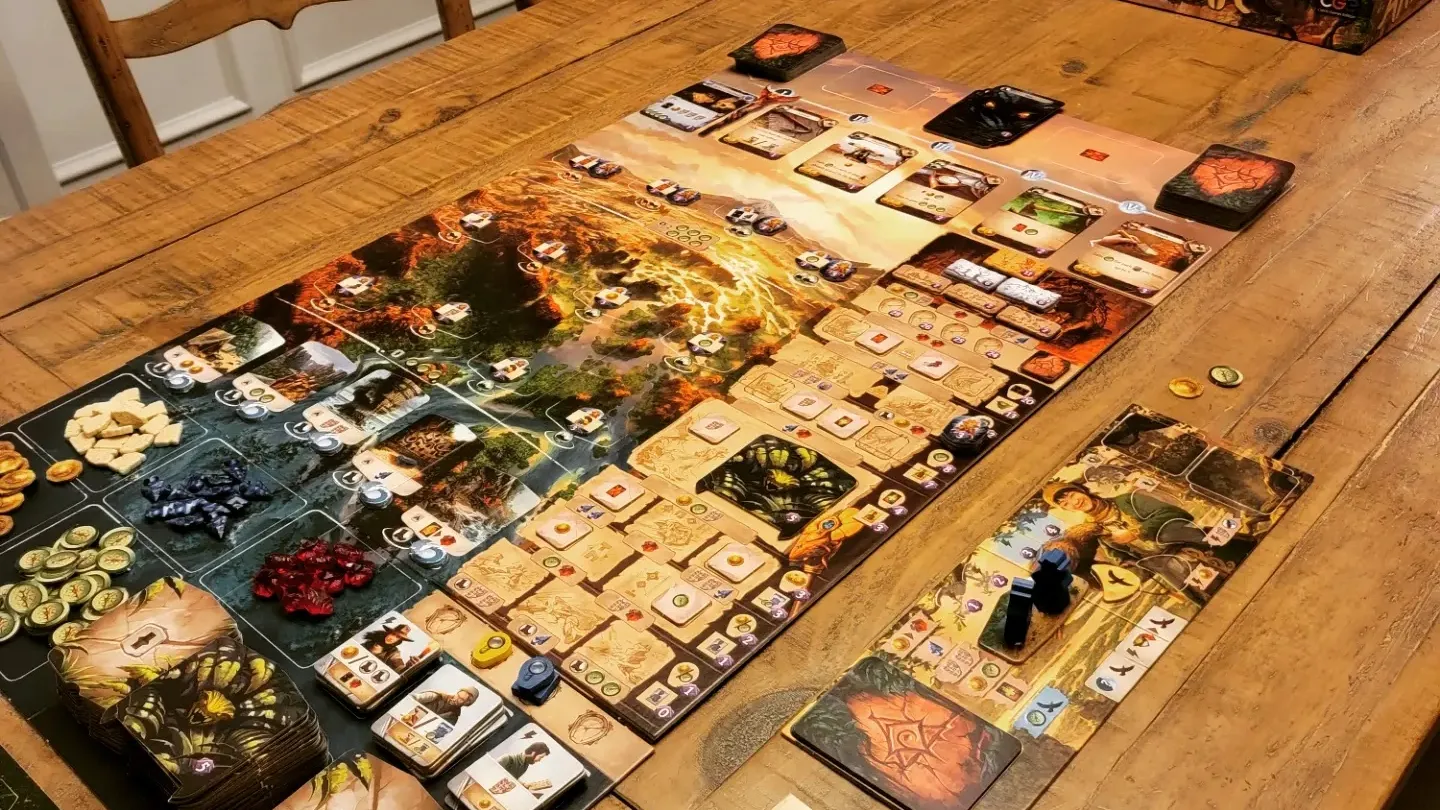
Simply put, the components in this game are beautiful. I’ll start with the cards because in a game like this, you’ll be spending a good deal of time looking at cards and who wants to waste their time staring at ugly cards? The cards consist of 4 types: your leader’s 4 starting cards, fear cards, item cards, and artifact cards. Besides the fear cards (which basically work like curses from Dominion), every single card has unique artwork on it that is rendered brilliantly, bringing out the theme of the game perfectly. While it is not uncommon for games that have a deck-building component to have unique art on every card, there are a lot of cards included in these decks (58 items, 47 artifacts, and 24 leader starting cards) and this attention to detail really propels the game up a level in my opinion.
In line with the cards, there are also a plethora of tiles (15 level one sites, 9 level two sites, and 20 guardians), all containing unique artwork that just screams “unexplored island with crazy monsters guarding it!” The tiles are thick and weighty and feel great when you’re unveiling them and placing them out on the game board. I really appreciate how the iconography on the tiles is easy to see and understand without taking away from the amazing art.
Then there are the Expedition Leader player boards. Each of them is covered in unique artwork (are you surprised?) and gives each player a true feeling for their character. A new player will probably love the artwork on the boards but feel a little intimidated by all of the icons and symbols. I am here to tell you that once you are half-way through your first game, understanding the board will feel like second nature. They are all designed in an intuitive way, even including markings to remind the player of the different variable player powers and when to trigger them.
Lastly, I want to touch on the main resources your character will be collecting in his or her travels. There is a total of 5 and while two are just cardboard chits (the coin tokens and compass tokens), the other three are crafted from plastic and help to bring out the art direction even more. There are white, rectangular tablets; blue arrowheads; and the elusive, red, and shiny jewels. This is one of those areas that would have been so easy for the creators to just put some artwork on cardboard chits and call it a day, but Min & Elwen took an extra step to upgrade these and increase the overall quality of life for the player. There are other components included and all are well-made so don’t think that just because I didn’t call them out, these pieces are sub-par.
Plenty of games look beautiful and pull out all the stops when it comes to the components, but then you get them to the table and “meh.” So, how does Arnak stack up in the vaunted gameplay category?
Gameplay
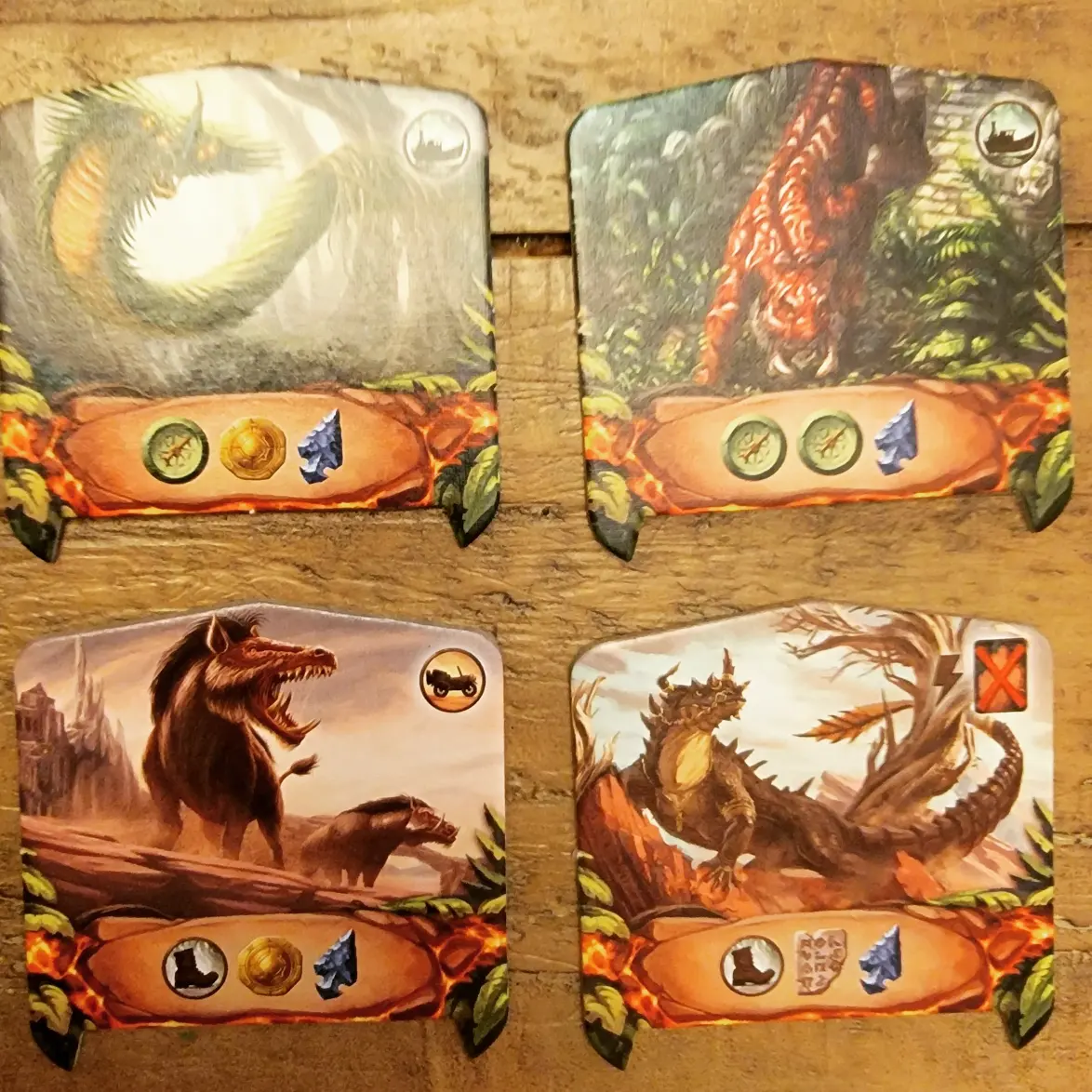
The game consists of players taking unlimited free actions (optional), and then one main action, thus concluding their turn. Free actions can include playing a card to get additional resources or activating certain variable player powers. The main actions include digging at a site, discovering a new site, overcoming a guardian, buying a card, playing a card, researching at the temple, or passing (thus ending your turn.) This is definitely one of those games where there is a lot that you’d love to get done but will never fit it all in. Each of the main actions (besides digging at a site and passing) is going to directly contribute to your victory points at the end of the game. In this, the game is a bit of a “point salad” and that can be a detractor to some people, but I don’t have any problem with this category of scoring.
My favorite part of the game comes in the form of how the worker placement and deck building intertwine, affecting each other throughout the game. Every card is printed with one of the transportation resources in the corner, causing a decision point when playing every card. Do you play the card for its effect? Or do you discard it, use it’s travel resource, in order to discover a new site and open up more places to send your workers. Giving the cards dual purposes is implemented perfectly and makes every card feel like a steppingstone that can be moved and shifted to create different paths to victory.
This mechanic is also done on a slightly smaller scale with the relics that you pick up after discovering a new site. These relics will always count towards 3 points at the end of the game, but your player board has empty relic slots, printed with an increasing number of victory points on them. A player can choose to “slot” their unused relics into these spots, foregoing the points printed on the slot. Instead, the player is able to choose from one of the special actions printed on the player board. This gives the player a nice decision point where they might be lacking in a resource to pull off a nice combo and are willing to sacrifice 1 or 2 (or even 4) points to get just the right resources to propel them forward.
My biggest call-out about the gameplay is that it can lead to analysis paralysis for some players, even those that might not usually fall into that trap. I’ve found myself a few times staring at the board and trying to figure out what cards to play, to place a worker in just the right spot to collect a resource, and then what assistant to exhaust for that other resource I will need to move my magnifying glass on the next turn which will get me that other resource that will finally let me pull off the combo I want to. While thinking through all this is fun for the player doing it (or it is for me at least), it can cause a lot of downtime for the other player, especially if they already know what they want to do on the next turn.
There are plenty of other interesting things going on here within the gameplay too. The game starts with 1 artifact card and 4 item cards in the market. As each round starts, multiple cards in the market are discarded, and more artifact cards (and fewer item cards) fill it back up. This gives the feeling of moving further into the island and having less access to items from the mainland but discovering more island artifacts. The refreshing of the market also creates some urgency to grab the cards you want as there is a good chance they will be discarded within the next round or two.
Earlier I mentioned the types of tiles and one of the types were the guardian tiles. When a player discovers a new site, they rewarded with whatever resources or actions are printed on the tile, but then a guardian immediately appears on that site. Each guardian is printed with a cost to “overcome” it and a player can take one of their main actions to do this. I really enjoy the “overcome” aspect because once this happens, you are given the guardian tile. Not only will these be victory points in the end game, but each guardian has one extra action or travel resource printed on it. At any point during your turn, you can flip the guardian over and trigger this action or resource. This is another way the creators have doubled the purpose of something, and it just works perfectly.
Lastly, I want to talk about the mechanism to trash (or “banish” as Arnak calls it) cards that you no longer want clogging up your deck. This game allows a player to banish a card from either their hand or their play area. Yes, another way to use a card two different ways! On one turn, a player could put in their play area a fear card and use the boots resource on it to dig at the compass site. On another turn or using a free action on a collected guardian tile, they could then immediately banish the fear card and remove it from their deck on future turns. I love the idea of never having any cards that are truly worthless and using a card until just the right time when it is no longer needed and banishing it to the discard pile.
Conclusion
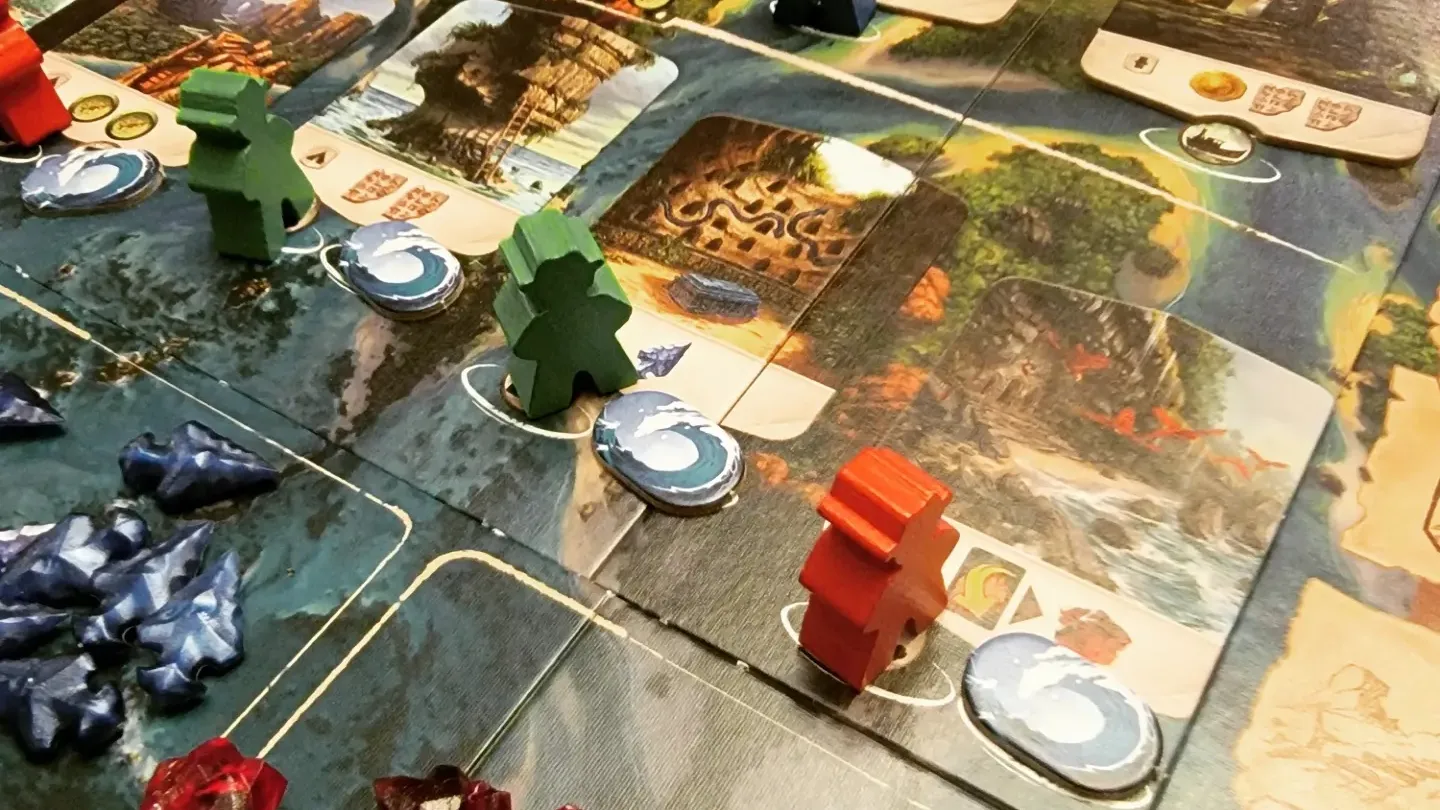
I’ve seen this game on a lot of people’s “best of” lists over the past year and was afraid that it was just being overhyped but I can say (for me) it hits on all cylinders and deserves any and all praise given to it. The mix between deck building, worker placement, and resource management is seamless, reminding me a lot of Everdell, one of my other favorites. While I have not played with more than 2 players, I have been very happy with this at the 2-player count and as a solo game (which I’ve written about here.) At 2-players, it wraps up in about an hour which I find to be a perfect amount of time for a game of this weight.
As I stated in the introduction, I would have to say that the Expedition Leaders expansion is a must-buy, as I don’t think I’d ever play without it and will even teach the base game + expansion to any new players in the future. If you’ve felt any pull towards this game but are still on the fence about it, I can almost guarantee that you will not be let down by the purchase.
Rating
Ratings are based on 5 main criteria: rulebook, setup, components, art & graphic design, and gameplay. The first 4 criteria are rated 1 to 5 and the gameplay is rated 1 to 10. These scores culminate in an “overall satisfaction” score that is rated from 1 to 10. If the reviewed game has both a solo and multiplayer mode, I have assigned scores separately to give context to which mode we enjoy more.
Links
As an Amazon Associate I earn from qualifying purchases.

